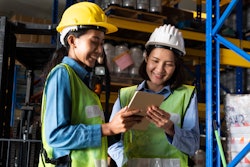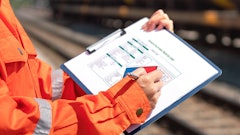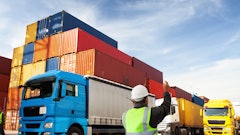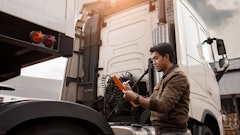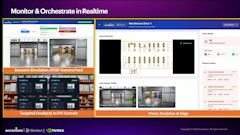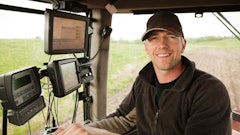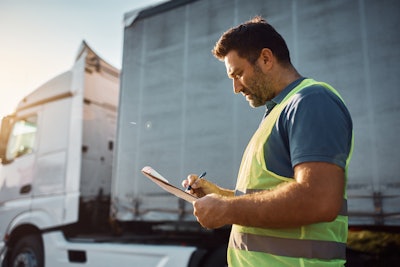
In logistics, the difference between a secure yard and a vulnerable one often comes down to who’s watching—and how. As cargo theft reaches alarming levels across North America, with nearly 75% of all incidents occurring at logistics facilities rather than in transit, the need for reimagined oversight has never been greater. For today’s warehouse managers and supply chain leaders, real-time visibility isn’t just a luxury—it’s mission-critical.
Historically, safety and compliance have relied heavily on trust and self-reporting. Drivers were expected to follow standard operating procedures—like pre-trip and post-trip inspections—on an honor system. While some individuals take these responsibilities seriously, inconsistencies abound. The result? Risk—risk of breakdowns, accidents, DOT penalties, and ultimately, financial loss.
What’s needed is a shift from reactive enforcement to proactive oversight, and the tools to do it at scale.
A new standard: Surveillance meets real-time intervention
The introduction of remote monitoring combined with high-resolution video and trained human agents has radically expanded what's possible. Instead of relying on boots-on-the-ground staff to monitor acres of yard space—a task that’s logistically difficult and cost-prohibitive—organizations can deploy centralized agents to oversee dozens of cameras simultaneously.
Even more powerful is the integration of live intervention. Using two-way audio, these agents can immediately address driver safety violations in real time: speeding in the yard, missing PPE, incorrect parking, or unauthorized access. This ability to voice down incidents the moment they happen is proving to be a game-changer for driver compliance.
Equally important is the capability to rewind footage. If an event is missed in the moment, it can be easily reviewed, categorized, and archived. Over time, this builds a rich dataset that allows for comparative benchmarking by facility, team, or individual driver. Weekly, monthly, and quarterly trends become visible, measurable, and—crucially—actionable.
From surveillance to strategy: Why insurers and partners care
The value of real-time oversight doesn’t stop at internal operations. Insurers increasingly reward facilities that can provide verifiable audit trails of safe practices. With a secure and documented oversight system, companies can present data that proves their risk profile has improved—often leading to preferred insurance rates and reduced premiums.
External stakeholders such as shippers and logistics partners also benefit. A facility that enforces safety standards consistently builds trust with its drivers, customers, and carriers. In fact, many of the most reputable logistics clients now require detailed records of safety and compliance practices before awarding business.
This isn’t just about avoiding loss—it’s about earning trust, proving excellence, and growing revenue.
Gate delays, risk trade-offs, and the inconvenience paradox
Here’s an underappreciated truth: you can be only as safe as you’re willing to inconvenience your drivers.
Gate management is a prime example. Requiring drivers to undergo multi-point inspections, identity verification, and load validation on both entry and exit dramatically increases security. But these practices can also slow throughput and cause long lines—sometimes stretching out to city streets, triggering municipal fines and driver frustration.
This is where smart gate management systems come in. The right technology can automate license plate recognition, BOL validation, facial recognition, and real-time CRM integration—all without sacrificing speed. When linked to live human operators who are trained in security, compliance, and software tools, these systems not only reduce delay—they enhance accuracy and enforce protocol with consistency.
The goal? Get safer without slowing down.
Why yards are the new frontline of supply chain risk
Logistics yards aren’t just where goods stop—they’re where risk concentrates. Whether it’s stolen loads, hijacked trucks, or unauthorized intrusions, criminal tactics have evolved to exploit the weakest links: open gates, untrained guards, and poor documentation.
And the vulnerabilities aren’t always high-tech. Something as simple as a $30 card reader purchased online can duplicate an access badge and allow a bad actor through the gate. In fact, up to 25% of logistics yards in North America still operate without any gating or perimeter control.
It’s no surprise that even mainstream media outlets are taking notice. A recent CNBC feature highlighted how criminals target unprotected yards, underscoring a growing national awareness of this issue. But industry insiders have long known: yards are the new frontline, and it’s time the entire ecosystem treated them that way.
Great operations produce great security
It’s tempting to think of safety, compliance, and security as separate functions. But in reality, they’re deeply intertwined—and they all stem from the same root: operational discipline.
When everyone in the facility follows best practices, anything outside of protocol stands out. Deviations become obvious and easier to intercept. With the right mix of trained personnel and responsive technology, operations become so efficient and consistent that security becomes a natural byproduct. It’s not just safer—it’s smarter.
At the end of the day, real-time oversight is more than just watching cameras. It’s about creating a culture of accountability, backed by data, driven by technology, and executed by professionals. And for logistics leaders looking to reduce risk, lower cost, and attract premium customers, that’s a frontier worth investing in.
Smarter yards = safer yards








